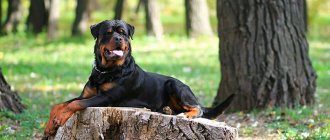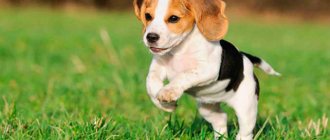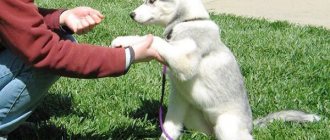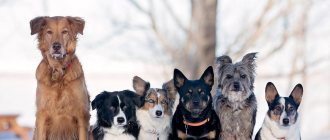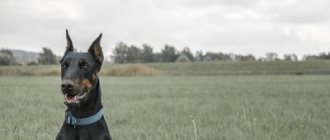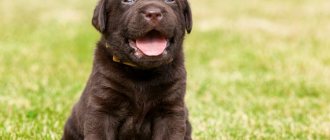Rottweilers are a working dog breed bred in the city of Rottweil.
These are excellent defenders and guards.
They are devoted to their owner, but not everyone can raise a dog correctly.
In order to prevent irreparable mistakes in training, you need to know the breed’s character traits and difficult periods in education.
This breed is devoted to its owner, it can and should be trained.
Are they trainable?
The dog has exceptional guarding qualities, but before you start training, you should learn about some of the features of the Rottweiler.
From the first days in a new home, a Rottweiler puppy chooses a leader with whom he establishes a subtle contact . It is this person that the dog will respect as its owner in the future; it is to him that he will listen most of all.
It should be kept in mind that in order to achieve such feelings from a dog, you need to be an absolute authority in its eyes.
You need to be patient, self-confident and persistent, and show these traits in relation to the dog as well.
These qualities come in handy because Rottweilers can be stubborn and disobedient..
A distinctive feature of a dog is its slow reaction. They move from one state to another a little slower.
It is important to wait so that during training you do not start to get irritated and thereby provoke aggressive behavior in the dog..
Rottweiler puppy training, when to start
Training a Rottweiler puppy must begin from the very first days
the presence of a dog in your home. There is an opinion that puppies should be trained no earlier than 6 months, but this opinion is erroneous, although quite widespread. From infancy, you need to instill in your dog the rules of behavior in your home, what is allowed and what is prohibited.
Often new puppy owners worry that training from the first days will be excessively stressful for the dog. This is only possible if outdated rigid methods are used, and with the right approach, training from the first days will be, on the contrary, very useful, since it allows you to immediately establish contact
with the puppy and build a trusting relationship.
What age is best to start?
Rottweilers begin to be trained from the age of one month . This is the time for name, toilet and leash training.
You need to know that the dog's character will gradually develop in the direction you need. The first months of a puppy's life are raised by a female dog, and he learns basic skills.
As soon as he gets into the house, you already take responsibility..
Read about how Rottweilers grow up here.
It’s impossible - it means it’s impossible
You are engrossed in playing with your puppy, and suddenly your baby starts tearing the wallpaper or biting your hands. This behavior is unacceptable, if you don't stop these actions now, you will face big problems in the future. Leaving your dog alone at home can lead to you returning to the “ruin.” Or you will be constantly afraid that the Rottweiler will bite you.
For such and many other cases, there are prohibition commands: “no”, “fu”. If you want your Rottweiler to stop what he is currently doing, use the "fu" command. Use the “no” command when you forbid your dog to perform an action you dislike once and for all.
Where to start training and how long you need to train
Raising a Rottweiler begins with toilet training, collar and leash training.
To avoid suffering from your dog's antics in the future, stop any behavior that could develop into a bad habit from day one.
NOTE!
Do not allow the puppy to grab hands, behave aggressively towards animals and other family members, and do not ignore if the dog suddenly stops listening to your commands.
At the same time, it is strictly forbidden to hit the dog or shout angrily at it. It is quite difficult to retrain this breed.
The most important rule that a future owner should learn is not to allow a puppy to do anything that an adult dog should not do..
You need to raise a Rottweiler using only persistence and patience. Using these qualities, try again and again to ensure that the dog follows your commands.
If the dog obeys and does what he is told, reward him. Over time, the Rottweiler itself will learn to distinguish the owner’s intonation and try to please him.
The dog's upbringing should be organized so that by 4-5 months it already clearly understands the boundaries of what is permitted . From 5 months the puppy will begin to show waywardness.
At this moment, the main thing is not to give up.
Rottweiler training should generally be systematic and long-term. The Rottweiler's first commands should be taught starting at 2-2.5 months.
You should not immediately load the puppy. The first training should not be long and only after the dog has already learned its name and gets used to you and the environment.
To begin with, the training should last no more than 30 minutes . As the puppy gets older, the training time needs to be increased.
The very first commands that should be taught to a Rottweiler are “Fu”, “Place”, “Near”, “Come”, “Sit” and “Stay”.
After the dog firmly knows and carries out these commands, you can teach him additionally more complex ones.
To ensure that the dog is not distracted by anything during the training process, you need to do this after a short walk in a secluded place - these can be specially designated places.
Commands must be given in a clear and firm voice . When done correctly, do not forget to reward the dog, for example, with his favorite treat.
If you notice that the dog refuses to follow commands or is distracted, take a break and change the place of training . Return to the training process some time later or the next day.
Don't forget to reinforce your dog's skills in other settings, such as at home or while walking. Also try to organize your workouts so that they take place at the same time and in the same place.
Expert opinion
Kozhevin Semyon Kirillovich
Expert dog handler.
“The attitude of a Rottweiler towards a potential owner largely depends on its behavior. If you give even the slightest slack in communicating with this dog, the consequence will be complete disrespect. It will be difficult or impossible to get rid of it at all. Therefore, I advise you to get this breed only if you are confident in your abilities. The dog has a slow reaction time, so it will take a lot of time to train, but the result is worth it.”
Puppy training
For a Rottweiler, training and education must occur in certain stages. These steps are important to know and understand, as they affect the development of an adult dog, its capabilities, character and behavioral characteristics.
3.1 Basic training method
The Rottweiler breed requires puppy training to be carried out with the simplest commands. For this, a variety of positive incentives are additionally used. If the dog does what is required of it, it can be given some kind of treat.
How to train an adult dog to behave outdoors
The most important thing a dog should do outdoors is go to the toilet.
First, you should train your puppy to go to the litter box . Then, when he walks there confidently and without missing a beat, slowly move the toilet towards the door.
When you start walking your dog, take with you a diaper that your puppy usually uses to relieve himself. A familiar smell will help him find his way.
When the dog gets used to the street, remove the tray. Walk your Rottweiler about 5-6 times a day. Over time, he himself will begin to ask to go outside.
If the puppy starts going to the toilet at home and on the floor, then the procedure will have to be repeated . For starters, it’s worth even rewarding the puppy for doing his “business” where he’s supposed to.
Also, in order for the dog to behave calmly during a walk, two to three weeks before the walk, begin to accustom him to a collar and leash.
Be prepared for the fact that your dog's behavior on the street may change, because it is full of new noises and smells.
It is quite possible that the dog will rush after a cat or a cyclist, so first choose deserted places for a walk.
You need to socialize your dog when it already listens to you and follows basic commands.:
- "Walk".
- "Near".
- "Aport."
- "Home".
All puppies are curious and emotional. This means that when walking, the dog will pull you in different directions, trying to absorb as much information as possible.
In this case, try to keep the dog near you, control his impulses . Do not forget to repeat the prohibition commands, while pulling the leash toward you, pulling the dog closer to your feet.
Make sure your puppy doesn't pick up trash from the ground.
When you are sure that your dog will listen to commands, start visiting dog parks so that he can communicate with his brothers.
If this is not done, then when meeting other dogs, the dog will rush at them, behave aggressively, or, on the contrary, be afraid . It is important that he knows that he is not the only dog in the world.
Manageable city dog
If there is no opportunity or desire to take official exams on a general training course with your Rottweiler, you can train your Rottweiler in the UGS course - a controlled city dog. Unlike OKD, where the assessment of completed tasks will be given by specialists of the Russian Canine Federation, the UGS course is held in any dog breeding club. Therefore, instead of an RKF certificate, the owner of a Rottweiler can only receive a club diploma.
Taking a city dog management course is especially recommended for owners who live in the city and constantly appear with their Rottweiler in public places. Training begins at six months.
The UGS course is designed to develop a Rottweiler into a companion who knows how to behave correctly in city conditions. However, there are more requirements in this course than in OKD. After all, work with dogs is carried out not only in closed dog parks, but also in other areas where there are many unpredictable urban factors and outsiders.
After completing the UGS course, the Rottweiler will learn the following:
- follow the commands “near”, “sit”, “lie down”, “stand”, “come to me”, “no”, “fu”;
- treat walking accessories calmly: leash, muzzle;
- do not show signs of anxiety during a manual examination of teeth, fur, ears, paws;
- calmly go out or enter the entrance, car, clinic, and so on;
- calmly cross an overground or underground pedestrian crossing;
- be comfortable on public transport;
- do not accept food from strangers;
- do not pick up food or dirty objects from the ground;
- wait for the owner on a leash in public places;
- overcome an obstacle course;
- concentrate attention on the owner;
- do not react to city noises.
In addition to the UGS course, an already one-year-old Rottweiler can take the ZGS course - a protective city dog. In addition to the skills of the dog, the dog will learn to obey while practicing protective functions, to grab an attacker on the command “face” and release on the command “throw it”, to repel an attack on the owner or other family members, to detain and escort an escaping person.
Like the UGS rate, the USG rate is not official. After passing it, the Rottweiler will receive a diploma from the Kennel Club.
Please tell us in the comments how you trained your dog.
If you liked the article, please share it with your friends and like it.
How to teach basic commands
Let the first command your puppy learns be “Sit.”
It will make caring for your dog much easier.:
- Firmly command your dog, “Sit!”, then lightly press his rump to make him sit.
- While the puppy is sitting, praise him while continuing to repeat the command. Repeat the process, then let your puppy follow the command on his own.
- If he doesn't follow through, repeat your steps again. When the dog begins to sit on his own, reward him.
It would be correct to learn the command “No” or “Fu”, because puppies love to chew or bite something..
If you see that the puppy jumps when he sees you, tell him in a firm voice: “No!” Don't allow him to do forbidden things even sometimes, otherwise he will get confused.
Also, if the dog chews something other than toys, or rummages around in the trash, repeat the command to him in the same firm voice, then move away, but do not take your eyes off.
If the dog continues to misbehave, repeat the command . If the dog bites you, then take him by the muzzle or the back of the head and tap the bridge of his nose several times with your fingers, repeating the command “No.” In this case, you need to say it sharply.
IMPORTANT!
If you have already forbidden your dog not to do something, then under no circumstances allow it again. The Rottweiler quickly learns about the weak point.
To prevent your dog from disturbing you while you are doing business, teach him the “Place” command.:
- First, the dog must know the “Sit” command. Command it to him, praise him, then bring your palm to the dog’s face, as if ordering him to stay in place, say: “Place!” and start walking away.
- Most likely, the dog will run towards you. Stop her with a firm “No!” and return, seat again and command “Place!” Do this until the dog remains in place.
- After that, approach him yourself and praise him.
- During your next training session, move away from your dog.
Learn the command “Come to me”:
- If the puppy is far from you, clap your palms on your knees and now in a loud and cheerful voice shout: “Come to me!” repeatedly.
- After the dog comes, reward and repeat this command.
- Then throw the treat he likes, when the dog runs after it, command again.
- When your Rottweiler arrives, praise him, give him a treat, and repeat the process again.
If the dog doesn’t want to come back, then wave at him a toy or treat that he especially loves, and don’t forget to command him “Come to me!” at this time.
Historical reference
Their endurance, balance and intelligence allowed them to cope with the work of a shepherd. The money received from the sale of meat was hung on the dog's collar in a place inaccessible to pickpockets.
These dogs were also harnessed to small carts to transport milk and meat.
They received a bad reputation quite recently, due to the irresponsible treatment of their owners and their use in dog fighting. These facts have unfairly spoiled the attitude of the common man towards Rottweilers.
How to teach guard duty
It is worth starting to train an animal at one and a half years old, but you need to prepare for this from an early age.
During training with a Rottweiler, commands that have already been learned are improved. At the same time, the dog learns to carry out the commands “Face!”, “Guard!”, “Sniff!”, “Search!”.
The dog develops a sense of smell, attentiveness, courage and distrust towards strangers.
As soon as the dog begins to actively sniff things, this is a reason to start teaching him the “Sniff” command.
Start by having your dog bring things with your scent. When the dog follows this command, begin to teach him to recognize the smell that you need.
It is also important to teach the dog not to injure an intruder when apprehending him . For the training to be successful, the dog must unquestioningly follow the “No” command. This team requires special equipment to train.
Taking the dog on a short leash, order using the command “Face!” attack your partner in a special suit. If the dog takes off, praise him by repeating the command.
Then have the helper attack the dog, delivering gentle blows to the front legs with the rod.
When a dog lunges at one hand, you need to substitute the other.
Don't forget to repeat the command from time to time. At the end, you need to allow a few seconds to pat the assistant on the sleeve. Then calm your dog down, take a break and repeat.
To teach a dog the guard command you will also need attributes. Tie her to a tree or post, command “Place!” and “Lie down!” Place the item next to it and order “Guard!”
An assistant should appear in 15-20 minutes. If the dog begins to bark aggressively and lose his temper, again command “Place!”, “Lie down!”. You need to achieve a calm reaction from the dog to a person who does not perform any actions towards him.
If the dog reacts calmly, the helper tries to take possession of the item near the dog . When you try to pick up an attribute, command “Guard!”
As soon as the dog growls and rushes, the helper should run away, and you praise the dog with a sharp “Good!” After some time, repeat this command. Make the exercise more difficult depending on how well your dog masters the skill.
General OKD course
Owners should send a mature dog to a kennel club. A specialist, of course, will provide better training. The Rottweiler, however, is a smart breed, and you can try to learn some, even complex, commands with it yourself. Very often, owners themselves teach their pets, for example, to carry out the orders “Stand”, “Sit”, “Lie down”, “Near” and “Fetch”. In this case, it is better to start training only after the dog is 6-8 months old.
Training scheme
Two months: training to go to the toilet in a diaper, training to use a collar and leash, beginning to practice simple commands.
Three months: learning to eat what you give, and not picking it up from the floor, accustoming him to using the toilet outside, continuing to learn simple commands.
Four to five months: full training.
Learning the commands “Come”, “Place”, “No”, “Sit”, “Lie down”, the dog should stop barking on demand.
Six months: learning more complex commands, beginning to prepare for the dog’s protective guard duty.
Seven months or more: consolidation of learned skills.
CAREFULLY!
Training a Rottweiler must be appropriate to its age and skills, otherwise the dog's intelligence will stop developing and it will become disobedient.
Exhibition training
The dog is prepared for exhibitions from the age of 2-3 months. In most cases, an inexperienced trainer will not cope with the task, since the animal must:
- treat large crowds of people and other dogs calmly;
- run next to the owner for a designated number of laps;
- stand up on demand;
- allow yourself to be examined by judges and experts.
Behavior at exhibitions
Training for walking
You need to do this from a very early age. Teaching an animal to be calm when walking on a leash is a skill that requires knowledge and patience from the owner. Teaching a puppy to a leash goes through the following stages:
- The dog examines and sniffs the leash.
- The owner puts a collar on the puppy so that he gets used to the new accessory.
- The collar is worn every time you get ready for a walk.
Important! It is strictly forbidden to remove the collar if the puppy persistently tries to do it himself. You should calm the dog down, redirect its attention by offering a toy, and only then remove the accessory.
History of the origin of the breed
This breed is considered one of the most ancient; their ancestors were Molosser dogs. They accompanied legionnaires back in the days of Ancient Rome.
The Rottweiler breed itself originated in the German town of Rot Weil in the eighteenth century.
Being descendants of the ancient Roman dogs - Molossians, Rottweilers were larger, had a more docile character and were very easy to train.
Previously, Rottweilers were harnessed to carts; the dogs were used to transport small loads. Moreover, Rottweilers were not only carriers, but also excellent guards. Today, photos of a Rottweiler can be found on the Internet.In 1921, the United German Rottweiler Club was created, which is of the unanimous opinion that these dogs should still remain working dogs.
Showing independence
Even recognizing you as a leader, the Rottweiler can take some liberties.
In this way he is trying to show you his independence. Trying to win the right to make decisions independently, the dog suddenly stops listening to you or deliberately does not do what you order. Don't give your Rottweiler a chance to change places with you. If you let go of the reins even once, you risk raising an uncontrollable dog that will behave badly both at home and in society.
Only firmness, severity and perseverance will help you overcome your puppy’s manifestations of independence and develop the habit of obeying you unquestioningly. Strictly suppress any impudence of the dog using the “no” command. When walking, do not let your puppy off the leash until he begins to obey you unquestioningly.
If you have experience in raising a Rottweiler, please share it with us.
If you liked the article, please share it with your friends and like it.
Proper care
Description of the Rottweiler breed includes proper care and its main stages.
- It is necessary to comb the coat a couple of times a week;
- You need to bathe your Rottweiler two to three times a year;
- He needs to be vaccinated;
- After a walk, the Rottweiler's paws are washed;
- The pet must be treated for parasites;
- He needs his ears cleaned every week;
- Teeth are brushed once a week.
Peculiarities
Properly raising dogs at home is not an easy task, although the positive characteristics of the described breed will help in the implementation of this idea. This requires thorough preparation and a thorough study of the characteristics of the breed and the theory of training. Dog handlers recommend turning to professionals if you have doubts about your abilities.
When you decide to take on training your pet yourself, without carefully studying a large amount of material, familiarize yourself with (at a minimum) the basic rules of training. Patience, calmness and severity - these qualities will help develop a balanced character in your pet.
It is necessary to teach your puppy good behavior all the time. At home, it is important to encourage his good deeds in any appropriate way.
This could be a treat or a pat . If the puppy does something wrong, you need to warn him and then raise your voice a little. When this does not help, you need to stand up, clap your hands, and show your superiority over him. Hitting a dog is unacceptable. Any family member can raise a Rottweiler puppy, but training is the privilege of only the owner.
General characteristics of muzzles
The mesh of the metal muzzle is made of nickel-plated wire. Some meshes may have a leather lining to protect the Rottweiler's short coat from abrasion. These muzzles are durable and do not require special care. The mesh does not make breathing difficult, but eliminates the possibility of bites.
However, the mesh cannot be used in winter - the Rottweiler's lips and tongue may stick to the metal. And in wet weather, the metal can become rusty. Due to leather inserts, diaper rash often appears on the dog's skin. During training, you run the risk of injury from being hit by a metal muzzle.
Closed leather muzzles can completely protect passers-by from Rottweiler bites. They are tightly fixed on the dog's face, leaving only the nose free. To prevent the Rottweiler's skin from suffering, the muzzle has holes for air ventilation. This muzzle is convenient in cold and rainy seasons. But in hot weather it is better to avoid it - the animal will not be able to breathe in it, sticking out its tongue.
Leather “baskets” are used in any weather. In it, the Rottweiler will breathe and drink some water with his tongue hanging out. He will also be able to pick up garbage from the ground. So the “basket” is only put on trained dogs who obey their owner unquestioningly. A few more disadvantages: leather “baskets” need to be constantly cleaned and lubricated with special oil. Over time, they become unusable.
Plastic muzzles are an excellent replacement for “baskets”. They are also used in any weather. At the same time, muzzles prevent dog bites and are easy to care for. But even here there are some drawbacks. Plastic can rub your dog's skin or crack at the wrong time.
For walks in public places, a bridle muzzle is suitable. It will securely fix the Rottweiler's mouth right in the middle, preventing its powerful jaws from opening. Wear-resistant and low-maintenance bridles are suitable for any time of year.
Tips from a dog handler
It should be remembered that Rottweilers have good intelligence and are easy to train. However, there is also a negative side of this breed - it is a slow reaction. Accordingly, a person needs to be patient when it comes to learning.
Attention! You can’t break down, much less beat an animal.
Each task is studied until the dog masters it. A significant advantage is that the Rottweiler will never forget a learned skill and will always perform it.
As you can understand, training is a complex process that requires a lot of dedication from both the dog and the person. If everything is done correctly, the animal will learn the necessary commands and will delight the owner with its obedience.
Short description
Rottweilers are massive, large animals, with well-developed muscles and a pleasant color.
Males are larger in build than females and heavier in weight - they weigh on average 50 kg, and females - about 40-42 kg. Height is 61-68 cm and 56-63 for male and female individuals, respectively.
The animal's head is medium in size, with prominent cheekbones. The Rottweiler's ears are triangular in shape, semi-erect, and also form a straight horizontal line with the top of the skull. The jaws are wide and the lips are black.
At first glance, it seems that the color of the breed is simple - black with brown markings. However, it has a complex structure due to the tan.
The tan is placed in the area of the cheeks, eyes, chest, neck, and front paws. The color of tan varies from gold to red-brown.
The dog’s character is dominated by the following qualities:
- courage, openness, decisiveness of action;
- Rottweilers do not show aggression without a reason;
- protection and security of the owner and his family with proper training;
- intelligence, excellent memory, quickly amenable to learning commands;
- cunning that can manifest itself with improper upbringing.
The lifespan of a Rottweiler is not too long - from 8 to 12 years
IMPORTANT!. With proper care and concern for the pet's condition, the dog can live for 16 years.
With proper care and concern for the pet's condition, the dog can live for 16 years.
But for this it is important to monitor his diet, provide high-quality care, regularly visit the veterinarian, and walk him daily.
Tail docking
Today, many breeders are arguing whether it is necessary to dock a Rottweiler’s tail or whether this is an optional procedure.
Why dock?
Today there is no need to dock the Rottweiler's tail. This operation is performed only to improve the dog’s appearance. There is an opinion that an undocked tail visually lengthens the body of the animal, making the appearance disproportionate. Most breeders are against surgical intervention, believing that it is cruelty to animals.
Interesting! In some countries, Rottweilers with undocked tails are of great value at exhibitions. Although docking up to two vertebrae at the base does not go beyond the standard.
In some cases, tail docking is a genetic necessity. After all, a tail twisted into a ring does not meet the standard.
Things to know
Innate character traits are, of course, what training should take into account. The Rottweiler belongs to a small group of dogs with a very balanced character. The processes of excitation and inhibition in these dogs are exactly the same. The only thing is that the transition from one emotional state to another is somewhat slower. This is how they differ from the same popular German Shepherds. However, such a small drawback is easily balanced by the durability of the skills developed and the reliability in executing commands.
Rottweilers are very smart and sensitive dogs. They do not tolerate loneliness well, and therefore require attention from the owner from time to time. In a family, the Rottweiler always chooses one owner. This is usually the most confident person. The fact is that Rottweilers, despite all their sensitivity, have very highly developed leadership qualities. And such a dog simply will not obey a weak-willed person.
